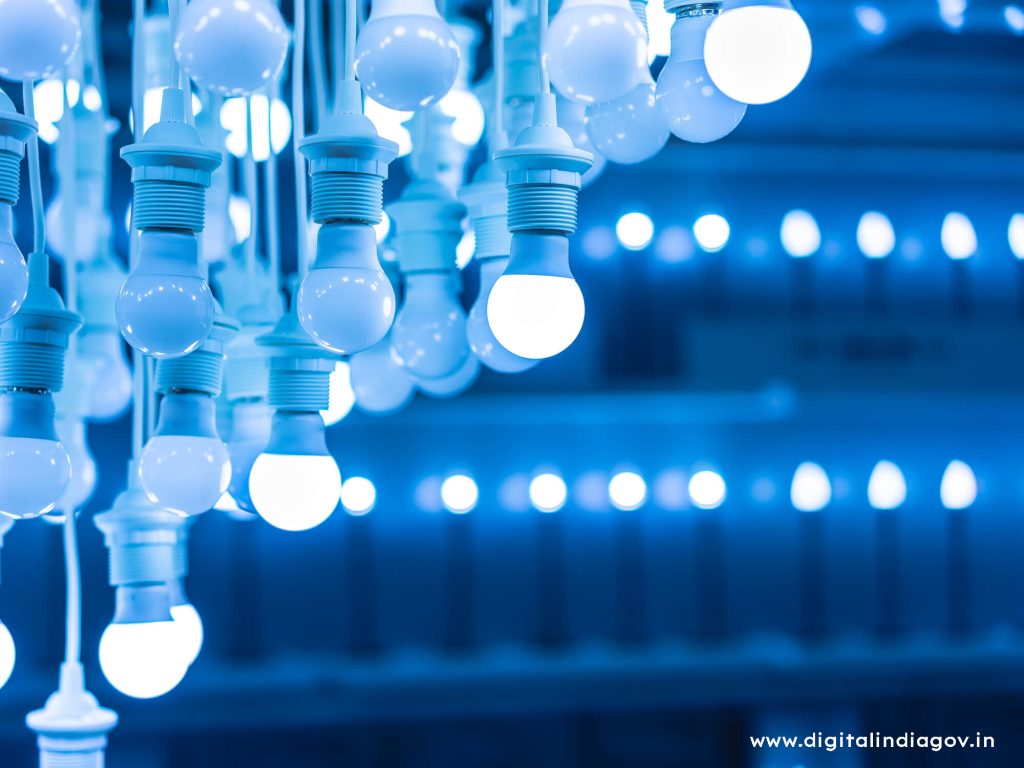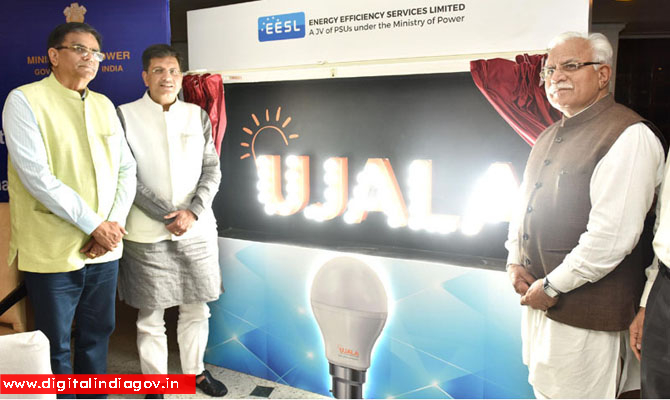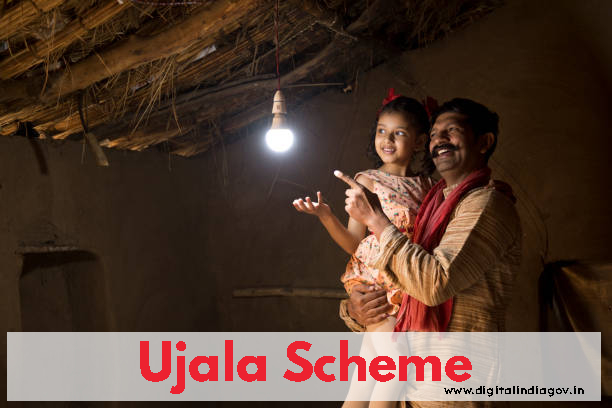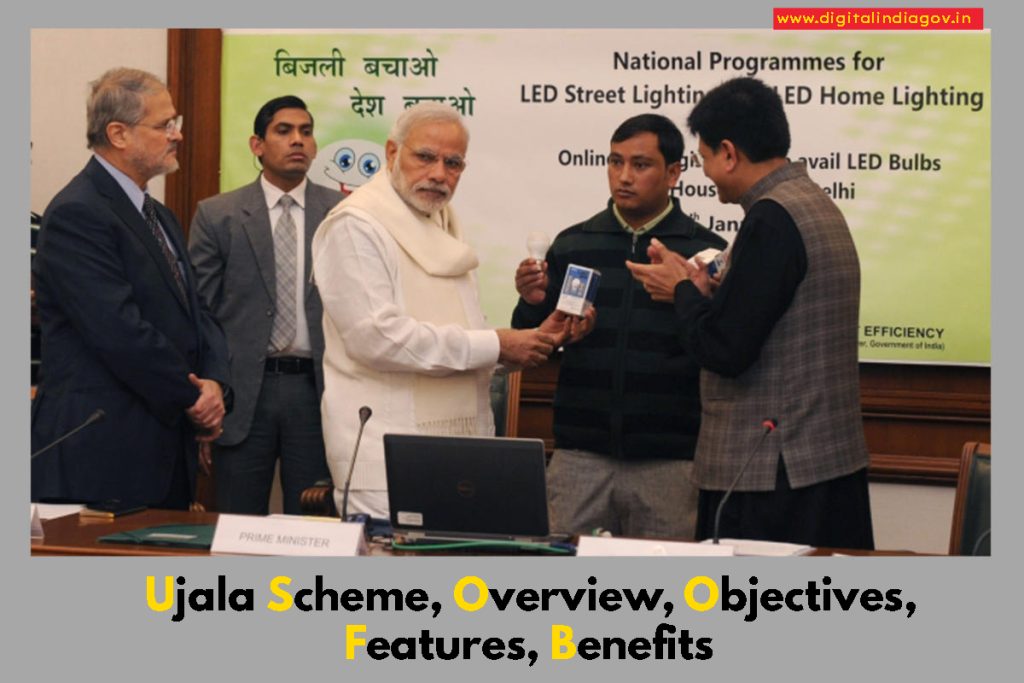Ujala Scheme:- In India, more than 25% of all electricity usage is by domestic users. According to a 2011 survey by the Ministry of Environment and Forests, lights accounted for almost 30% of all domestic energy consumption. In Indian households, the most popular lighting options were CFLs, tube lights (Fluorescent lamps), and Incandescent Light (ICL) bulbs. In 2012, the Electric Lamp and Component Manufacturers Association of India (ELCOMA) reported that approximately 40.8 crore CFLs and 75.8 crore ICLs were sold in India. Ten years ago, in 2002, there were only about 2 crore CFLs in existence. But because of recent advancements in technology, light-emitting diode (LED) bulbs are starting to gain popularity in the Indian market. LED lighting will take the place of 78.5 crore ICLs.
Contents
What is the Ujala Scheme?
The Ministry of Power launched the UJALA project in May 2015 to entice people to replace their incandescent or CFL lightbulbs with LED ones. This article’s goal is to provide an overview of the UJALA scheme’s current implementation status. Moreover, it illustrates the potential energy savings linked to the utilization of LED lamps.
The Indian government has launched a groundbreaking project called Unnat Jyoti by Affordable LEDs for All (UJALA). It seeks to illuminate the shadows. The Light Emitting Diode is a new technology that the Ujala plan has introduced (LED). LEDs are causing a revolution in lighting as they are installed in millions of homes across the country.

Also Read:- Pradhan Mantri Ayushman Bharat Yojana, Digitize India, Digitize India Platform, Work From Home Jobs, Celebrity Phone Number
Background
The lighting industry in India contributes about 20% of total consumption. For both public and domestic places, traditional incandescent light bulbs, which are inefficient, now meet most lighting needs.
With 77 crore inefficient lightbulbs to be replaced with LEDs, the Indian government is committed to seeing this aim through. This will allow for an annual reduction in load of 20,000 MW, energy savings of 100 billion kWh, and an 80 million tonnes decrease in greenhouse gas emissions. This is approximately equal to constructing five large thermal power plants across the country. Furthermore, a nationwide reduction of Rs 40,000 crore will be implemented in the prices of power for consumers.
To locate the distribution kiosk closest to your house, go to the Domestic Efficient Lighting Programme. By using less energy, everyone who switches to LED bulbs will be able to assist someone else in lighting their home.
Brief facts about UJALA
| Important facts of UJALA for UPSC Prelims | |
| What is the full form of UJALA? | Unnat Jyoti by Affordable LEDs for All |
| When was the scheme launched? | 1st May 2015 |
| Under which Government Ministry, the scheme was launched? | Ministry of Power |
| How is the LED bulb described by the Prime Minister? | “Prakash Path” – “way to light” |
| Who is the implementing agency of this scheme? | Energy Efficiency Services Limited (EESL) |
Objectives of the Ujala Scheme
- to implement a nationwide, phase-by-phase LED distribution system.
- Increasing public awareness of the importance of energy efficiency is the aim.
- to encourage energy-efficient living across India’s households.
- to convey the notion that energy efficiency has a long-term effect on environmental preservation.
Features of the Ujala Scheme
- On May 1, 2015, the Unnat Jyoti by Affordable LEDs for All UJALA initiative was introduced. Its objectives are to promote energy efficiency in households and raise consumer knowledge of the usage of energy-efficient equipment to lower electricity costs and enhance the environment.
- The initiative promotes the use of LED lightbulbs in place of CFL, incandescent, and tube bulbs.
- Through dedicated counters that are only located at approved locations across the country, LED bulbs are made available at discounted costs as part of the UJALA scheme.
Components of the Ujala Scheme
Aim of the Ujala Scheme
The government plans to switch out all 77 crore inefficient lightbulbs across the country with LED ones by 2019. The replacement will lower demand by 20,000 MW and cut greenhouse gas emissions by 80 million tonnes annually. Energy Efficiency Services Limited is carrying out the project (EESL). Four state-owned electrical businesses have merged to establish the EESl, which is under the Ministry of Power. NTPC, PFC, REC, and Power Grid Corporation are these electricity providers. State governments are freely implementing the Ujala system. 26 states and 6 union territories were taking part in the Ujala program as of November 18, 2016. Manipur, Tripura, and Arunachal Pradesh have not yet endorsed the plan.
Eligibility
Any home with a metered power connection with the applicable Electricity DISCOM qualifies as a beneficiary. The applicant just has to present government-issued identification—such as a passport, voter ID, or Aadhar card—when making an upfront payment. You also need to include a copy of your most recent power bill with your EMI payment.
Price
UJALA LED bulbs are 9W and range in price from Rs. 75 to Rs. 95 per. The little differences between states are brought about by differences in the relevant taxes, delivery expenses, and other comparable considerations. You have the option to pay for the LED bulb in full or by making bi-monthly or monthly payments on your electricity account. In Gujarat, for instance, customers have the choice of paying in whole or on an installment plan for each lightbulb. If you choose the EMI option, the total amount you pay will be Rs. 75, plus an additional Rs. 20 for their bi-monthly power payment for four billing cycles.
Distribution
DISCOM offices, particular EESL kiosks, weekly “haat” markets, and electricity bill cash counters are all places to buy UJALA LED bulbs. The UJALA website (www.ujala.gov.in) lists the locations of each choice. The Ujala Scheme allows a customer to buy up to 10 bulbs.
Complaint
For a period of three years, EESL will replace UJALA LED bulbs at no cost in the event of a technical malfunction. Customers can file complaints with UJALA using the company website, social media profiles, distribution kiosks, and customer care service centers. Up until August 2016, the overall failure rate of UJALA bulbs was less than 0.3 percent, with Delhi having the highest rate (0.97 percent). Because of the incredibly low defect rate, EESL has chosen to replace every bulb as soon as a complaint is filed.

Also Read:- Rajasthan Free Scooty Yojana, Digitize India
Implementation of the UJALA scheme
Concerning investment and risk issues, the UJALA initiative was executed effectively. DISCOM and EESL provided assistance in implementing the plan. Among the results that the UJALA scheme presented were:
- There will be a 200 million standard light bulb replacement with LED bulbs.
- A 5000 MW reduction in load.
- to cut carbon dioxide emissions from greenhouse gases by 79 million tonnes.
Overall Targets
UJALA LED bulbs:
- The whole goal of replacing 770 million LED bulbs in three years
- Expected annual energy savings – 105 bn KWH
- Expected reduction of peak load – 20,000 MW
- Annual estimated greenhouse gas emission reductions – 79 million tonnes of CO2
Why LED bulbs?
Because light-emitting diodes (LEDs) produce more light while using a tenth of the energy of conventional bulbs, the UJALA initiative concentrates on the distribution of LED bulbs. Additionally, the goal of this program is to provide consumers with 20W LED tube lights, which use 50% less energy than conventional 40W tube lights. However, the expensive cost of these LEDs has hindered the adoption of these energy-efficient lighting systems. The DELP on-bill financing plan aims to get around this expense barrier because LED lights are very effective at lowering load, consumer bills, greenhouse gas emissions, and power consumption.
UJALA Scheme in Malacca, Malaysia
After the UJALA system was introduced successfully in India, the same concept was also implemented in Malacca, Malaysia on September 6, 2017. The then-chief minister of Melaka introduced the UJALA program for the welfare of the local populace. This scheme’s main goal was to reduce electricity consumption in order to lessen the load on consumers. Global environmental preservation was another of its main concerns.
Every Malay home will receive 10 premium 9-watt LED lights for RM 10 as part of the UJALA program.

Also Read:- Khelo India Youth Game
FAQ’s
Q. For whom is the Ujjwala scheme applicable?
Ans- Apply online for the Pradhan Mantri Ujjawala Yojana (PMUY) today. Applicants for this benefit must be Indian citizens who are at least eighteen years old. Women who are part of a family that is below the poverty line (BPL) and does not have access to LPG are the main beneficiaries of this benefit. The woman cannot receive any more benefits of this kind from any other programs.
Q. Is the Ujala plan still in operation?
Ans-The Pradhan Mantri Gramin Ujala Yojna is one such programme. The program’s goal was to supply reasonably priced LED lightbulbs to every rural Indian household. After seven years, the Pradhan Mantri Gramin Ujala Yojna is still going strong.
Suggested Link:- Our Jharkhand
@PAY
